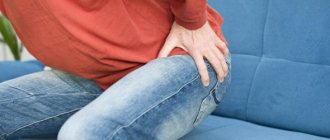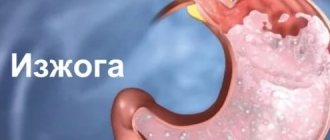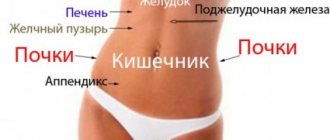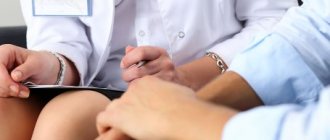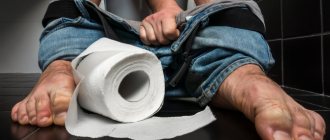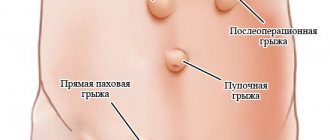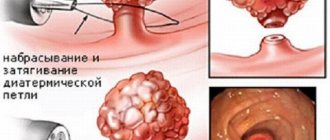Why does such pain occur?
Pregnancy
Painful sensations in the anal area during pregnancy are not a normal condition, and if they occur, you should consult a specialist.
At this time, the body is as weakened as possible and vulnerable to infections. Most often, hemorrhoids occur during pregnancy, which can be external or internal. If treatment is not started in time, it can become chronic. Internal hemorrhoids are characterized by nodes in the rectum that are not visible upon visual examination. In this case, the patient may feel a feeling of heat, pain radiating to the sacrum or back, and itching. Sometimes severe bleeding occurs. External hemorrhoids are mainly located around the anus and often lead to pain during bowel movements.
Hemorrhoids can be caused by:
- Frequent consumption of alcoholic beverages;
- Spicy foods;
- Constipation;
- Frequent diarrhea;
- Sedentary lifestyle;
- Pregnancy and childbirth.
Hemorrhoids develop very quickly if left untreated. The disease is characterized by acute pain when walking, sitting and even lying down. Body temperature may rise and loss of strength may occur. The hemorrhoidal node enlarges and subsequently falls out.
Most often, hemorrhoids appear in the second half of pregnancy. During the birth process, his condition worsens significantly. Women who have given birth to at least one child have hemorrhoids 5 times more often than women who have not given birth. This can be explained by the pressure of the enlarged uterus on the pelvic floor and hemorrhoidal plexus. Childbirth is often accompanied by constipation, which only aggravates the situation.
The appearance of hemorrhoids during pregnancy can affect its normal course and the course of labor.
That is why at the first signs of the disease it is necessary to consult a specialist. If left untreated, hemorrhoids can cause:
- Anemia;
- Arthritis and arthrosis;
- Diseases of the genitourinary system;
- Acne.
The nature of the pain is nagging and aching, occurring when walking. In a calm state, the pain subsides. With acute inflammation, more severe pain is possible, which radiates to the anus.
In the rectal area, a large number of vessels are concentrated, which form venous plexuses located under the skin around the anus.
During menstruation, blood flow to the pelvic area increases, which can cause blood stagnation.
This is especially observed in women who have low vascular tone and a tendency to varicose veins. The main signs of blood stagnation are:
- Nagging pain in the lower abdomen that radiates to the rectum;
- Constipation;
- Pain during bowel movements.
Pregnancy
Types of pain and causes of their occurrence
Painful sensations can be of a different nature, that is, they can be sharp, aching, pressing, and very often the pain in the anus radiates to the abdomen. Sharp and intense ones may indicate the presence of tumors, for example, rectal cancer, severe metabolic disorders, hemorrhoids and other diseases.
Aching and dullness can indicate the onset of an abscess; they are often accompanied by pus from the anus. The anal area looks swollen.
Such painful sensations are often accompanied by diarrhea or constipation, worsen when sneezing or coughing, and when you sit down, it radiates in the anus.
Also, proctologists note that the unpleasant sensations can be pulsating, which indicates a disease such as paraproctitis , which is also accompanied by an increase in temperature and strong pulsation in the anal area.
Pain bursting in the rectum most likely indicates the presence of hemorrhoids, or rather their thrombosis. A person feels the presence of a foreign body in the anus, which intensifies with movement, sneezing, coughing, or defecation. The same type of pain in the anus in women extending to the lower abdomen may indicate the development of an ovarian cyst.
The cause of pain that radiates to the lower abdomen can be various diseases related to the field of proctology and gynecology. A person who experiences such types of painful sensations as:
You must visit a proctologist who, based on examination and tests, will prescribe treatment.
What diseases can cause pain in the lower abdomen and lower back, except for hemorrhoids?
Varicose veins of the rectum make themselves felt towards the end of the second stage. The nodes fall out more often with the slightest physical exertion, movement, sneezing and defecation. The pain is concentrated mainly in the perineal area, although it can radiate to the lower abdomen and the right side of the groin. The lower back may also hurt.
In the absence of the main symptoms, pain can be caused by other diseases.
The lower abdomen may hurt if you suspect:
- cancer of the intestine, rectum;
- polyps, neoplasms in the large intestine;
- colitis, proctitis and paraproctitis, other inflammatory processes of an infectious and non-infectious nature;
- inflammation and exacerbation of prostatitis, prostate adenoma, prostate cancer in men;
- gynecological disease in women;
- anal fissures;
- inflammatory processes requiring surgical intervention - appendicitis, ectopic pregnancies;
- Crohn's disease;
- helminthic infestations.
Lower back pain is caused by:
- diseases of the spinal column - osteochondrosis of the sacrum and lower back, radiculitis, lumbago;
- pathologies of the genitourinary system and excretory tract - ureters and urethra;
- exacerbation of chronic prostatitis in men, uterine fibroids in women.
Only diagnostics and consultation with a specialist will help to accurately determine the subjective causes of the unpleasant sensations that appear and answer the question of whether hemorrhoids can radiate to the lower abdomen in this particular situation.
Hemorrhoids may not hurt immediately. This is its danger. The only way it can manifest itself is the appearance of nagging pain in the lower abdomen, indicating the appearance of internal nodes. But for now they are soft, elastic, do not get injured and do not bleed.
As the educational process increases, the main symptoms of the disease begin to appear. Their nature and strength depend on the patient’s condition, his age, pain threshold and other indicators.
The appearance of uncharacteristic pain associated with the disease does not always occur and is associated with the individual characteristics of the patient. They occur with hemorrhoids in:
- lower abdomen;
- left side;
- genital area;
- coccyx area;
- lower back.
There are several reasons why they arise.
Gastrointestinal tract disorders
- Inflammatory processes cause constipation, bowel movements occur at the wrong time. The stool hardens. When passing through the intestinal mucosa, they stretch its walls, which contributes to the appearance of pain in the lower abdomen.
- Injury to the mucous membrane and perineum by feces can cause anal fissures with the subsequent development of proctitis and fistulas, in which the pain radiates to the lower back and pulls the lower abdomen.
- With diarrhea, intestinal motility is disrupted, which causes discomfort in the abdominal cavity.
- Improper functioning of the gastrointestinal tract, disruption of metabolic processes causes gas formation and bloating. The intestinal walls become stretched, and a cramping pain syndrome similar to intestinal colic appears.
Radiation of pain
This is the process of spreading pain beyond the affected or inflamed organ as a result of the presence of many nerve endings in it.
The perineal area is one of these. Pain is easily transmitted along large nerves to neighboring organs located in the abdominal cavity. Hence the pain in the lower back, tailbone, and back.
Intestinal infection
Stagnation of feces causes disruption of microflora, penetration of infections and other pathogenic microorganisms, and provokes the occurrence of inflammatory processes. The painful syndrome in this case is abdominal in nature, that is, it appears in the navel area, in the upper middle part of the abdominal cavity or in its lower left section.
Psycho-emotional state
Often, when defecating with hemorrhoids, the pain is so intense that when remembering it, a person puts off going to the toilet, which only aggravates the situation and provokes long-term constipation and hardening of the stool.
The nervous system is at its limit, the patient complains of headaches and dizziness, insomnia and nausea.
The placebo effect occurs when, with the memory of an unbearable pain syndrome, a person begins to feel unpleasant symptoms in the abdomen, groin, tailbone and back.
Among women
At the early stage of hemorrhoids, nagging pain in the lower abdomen, a sensation of a foreign body and discomfort require additional examination, as they may be associated with problems in the genitourinary organs, gynecological pathologies - uterine fibroids, ovarian cysts, neoplasms of a malignant or benign nature.
Symptoms of hemorrhoids may intensify during menstruation, pregnancy, childbirth and anal sex.
The loss of hemorrhoidal cones at stages 2 and 3 of the disease requires a visit to the gynecologist, as it can cause the appearance of gynecological diseases.
In men
Just like in women, the first signs of pain in the lower abdomen or lower back may indicate the onset of inflammatory processes in the genitourinary organs - prostatitis and cystitis. You need to contact a urologist.
In later stages of hemorrhoids, the nodes become visually visible or palpable during rectal examination, which confirms the pathology.
What causes sharp pain?
- Anal fissures. They cause severe pain that is oppressive in nature. There is a delay in defecation and frequent constipation. In the chronic form, pain may not appear. The cause of the disease is a defect in the mucous membranes, which occurs due to injury from foreign bodies or feces.
- Proctitis. In the acute course of the disease, sharp pain is observed, which is accompanied by a loss of strength and an increase in temperature. At the time of bowel movement, purulent or bloody discharge appears. When proctitis becomes chronic, the pain becomes less pronounced.
- Thrombosis. Inflammation of hemorrhoidal veins. The disease develops rapidly, which is characterized by increased pain. There is an increase in the hemorrhoidal node, which can fall out.
- Rectal prolapse. The pain is so severe that the person may lose consciousness. Most often occurs in older women who have had many pregnancies. Treatment is surgical.
- Anal ulcers. They arise as a result of untreated or improper treatment of anal fissures, hemorrhoids and inflammatory diseases of the rectum.
- Inflammation of the appendix. Leads to severe pain that radiates to the rectum. In addition, there is a sharp pain in the stomach and area around the navel, in some cases it cannot be localized. Changing position and coughing lead to increased pain. There is an increase in body temperature.
- Polyps in the rectum. In addition to pain, bleeding, constipation or diarrhea are observed. Requires mandatory removal.
- Subcutaneous paraproctitis. Other causes of acute pain include subcutaneous paraproctitis, which is suppuration in the rectum. It is characterized by an increase in body temperature and the development of general intoxication of the body.
Soreness in the rectal area can occur in healthy people. In most cases, pathology appears after anal sex, especially if a variety of sex toys are used.
Minor pain may occur for a short period of time after prolonged sitting.
Pain that occurs during pregnancy
Quite often, a woman who is in an interesting position complains of various pains in the lower abdominal segment. One of the ailments that gives such symptoms is the threat of miscarriage. If you suspect such a development of events, you should immediately consult a specialist and begin treatment.
Also, such pain, radiating to the rectum, can be a harbinger of an early birth. If the pregnancy is full-term, then there is no need to worry. However, it is worth reporting your new sensations to a specialist and getting qualified advice.
Let's look at the main causes of pain in the anus in women and tell you when treatment is necessary.
Discomfort that increases with the passage of feces indicates that a crack has formed in the wall of the rectum.
Usually the phenomenon makes itself felt only during bowel movements. This happens at the moment of pushing out a too dense fecal bolus.
In rare cases, the rectal mucosa can be damaged by foreign objects that entered the gastrointestinal tract with food and, without being digested, were excreted.
For example, fruit pits, seed husks, etc. Diarrhea can also cause discomfort in the anus.
First, you need to establish the cause of the diarrhea and eliminate it, and only after that begin to treat the inflammation that has arisen in the anus.
The source of persistent diarrhea may be the development of diverticulitis (an inflammatory bowel disease), colitis, polyps or tumors.
Painful sensations that bother a woman for a long time and intensify at the time of bowel movement indicate that the resulting fissure has become inflamed and has acquired an aggravated form.
The pain that occurs due to the formation of a crack is much more piercing than with hemorrhoids. In rare cases, it becomes so intense that it can cause screaming.
There is a delay in defecation, resulting in constipation.
Often women experience spasms and pain in the anus, which radiate to the perineum and sacrum.
The functioning of the genitourinary system is disrupted, which leads to difficulty urinating and disruption of the menstrual cycle.
For some women, the discomfort lasts for a long time. The reason is regular damage to the wall of the rectum; spasms of the sphincter muscles last longer and longer.
Sometimes the pain may linger until the next act of bowel movement follows.
Until the main cause of discomfort in the anus is eliminated, that is, the fissure, the sensations will become more and more intense, and will soon become completely unbearable.
Cracks in the anus may be accompanied by the following symptoms:
- piercing pain during bowel movements;
- discharge of a small amount of mucus with blood clots.
Cracks often appear on the back wall of the anal canal, sometimes on the front, and very rarely on both at the same time.
The most serious disease developing in the anal area is considered to be damage to the walls (wounds, cracks) that has spread throughout the entire area of the anal canal. Then we can talk about the presence of oncology.
Cancer that develops in the rectum does not go away without clinical signs.
The most important symptom of oncology, which cannot be ignored, is the release of bright scarlet blood clots along with the stool.
The second, no less significant sign is piercing pain.
The sensations usually occur during the passage of feces, and do not subside for a long time, but, on the contrary, intensify and become regular.
Sometimes the pain can be transmitted to the genitals, thighs, and lower abdomen.
Perineal injury
Pain in the anal area may not always indicate oncology.
Many people complain of discomfort due to regular bowel movements of hard stool.
Injuries to the perineum can also cause pain in women in the anus. These are falls, bruises, blows.
How does the stomach hurt with hemorrhoids: characteristic signs and manifestations
Hemorrhoids may cause pain in the abdomen, lower back, other parts of the body, and internal organs located close to the anus and intestines.
Hemorrhoidal pain syndrome has its own differences and characteristics, with the help of which one can accurately say whether the painful sensations are associated with this particular ailment or with some other one.
How can your stomach hurt with hemorrhoids?
- The nature of the pain can be aching, constant, cramping, or sharp.
- Occur during defecation or a few minutes after.
- Increased pain occurs after prolonged sitting.
- It often radiates to the lower back or right side.
- They are always accompanied by bleeding from the anus during trips to the toilet, which is caused by a violation of the integrity of blood vessels with solid feces during constipation and causes sharp, often unbearable pain in the abdomen and groin area. Blood remains on the napkin even with cracks in the anus.
- They acquire a sharp pulse-like character with a strong inflammatory process and the formation of blood clots.
- Cramping pain occurs when hemorrhoids prolapse and the rectal lumen narrows.
- The pain becomes constant and debilitating when the disease is advanced and is no longer associated with bowel movements. Severe inflammatory processes can be caused by the addition of concomitant diseases - peritonitis, necrosis, etc.
Too large hemorrhoids are dangerous, they can lead to complete intestinal obstruction, become a source of infection, an open gate to any pathogenic microorganism. This is what happens due to a decrease in immunity during the course of the disease.
To complete the clinical picture, the main symptoms of hemorrhoids should be added - burning and itching in the perineum, bloating, gas formation, constipation, nausea and vomiting.
Anal vein thrombosis
A complication of hemorrhoids, in which severe pain occurs in the anus, is thrombosis of the veins of the anal area. The mechanism of its development consists of several points. First, in the section of the rectum where the characteristic lump appears, the inner wall of the vessel is damaged. Here a blood clot begins to form and grow, which interferes with normal blood flow, causes congestion in the vessel, then a focus of inflammation and swelling appears. Such changes are accompanied by constant discomfort. Excruciating pain makes the process of bowel movement very difficult.
Main reasons
Most often, women feel dull pain in the anus during menstruation. There is an internal cavity between the rectum and the vagina, and during menstruation, a small amount of fluid may accumulate in it, which puts pressure on the anus. The discomfort may last a couple of days, after which it goes away on its own.
Aching pain in the anus can occur with papillitis, gynecological diseases, inflammation of the urinary system, cryptitis and STDs.
If pain occurs only at night, then we can talk about proctological fugue, which is muscle spasms.
This pathology is not a disease and goes away on its own.
Abdominal pain may not be a symptom of all diseases, but most problems in the gastrointestinal tract can be recognized thanks to the manifestations of painful sensations in the abdominal area:
- Acute surgery – appendicitis. The pain is quite strong, gradually descending to the lower abdomen from the upper floor of the abdominal cavity. Characteristic disturbances in the general condition are fever, nausea, vomiting. Intestinal obstruction – cramping pain, retention of stool and gases.
- Intestinal adhesive disease (history of intestinal surgery).
- Diverticulitis is pain in the lower abdomen on the left side with nausea, gag reflex, and blood in the stool.
- Diffuse polypous growths of the colon.
- Inflammatory processes in the urinary tract - cystitis, pyelonephritis, urolithiasis, with pain in the lower abdomen and lower back. Characteristic symptoms include dysuria, low-grade fever, and changes in urine tests.
- An anomaly in the large intestine - megacolon, characterized by constant constipation, flatulence, periodic bouts of fatigue, and poor appetite. The data is confirmed by x-ray or ultrasound.
- Irritable bowel syndrome – pain combined with diarrhea and flatulence or constipation.
- Infectious diseases and parasitoses with a predominance of colitis symptoms (tenesmus, frequent stools with mucus, cramping pain in the lower abdomen).
- Inflammatory bowel diseases (Crohn's disease, colitis - nonspecific ulcerative or others).
- Oncology (rectal cancer). Pain appears already at a late stage with large tumor sizes.
- The lower abdomen hurts due to radiculitis, inflammation of the sciatic nerve - the pain radiates to the leg on the corresponding side, the genitals and anus.
In each specific case, only a doctor will be able to determine the cause of the pain and try to eliminate the problems.
The cause of pain in the anus in women is wearing uncomfortable, tight underwear, and the use of low-quality sanitary pads during menstruation. Due to rubbing, not only the genitals, but also the anal area are affected; the resulting inflammation has an irritating effect on the woman’s anus, pain and discomfort occurs, with accompanying itching, burning, redness, and the appearance of wounds or ulcers. In advanced cases, it is painful for a woman to sit down and perform a bowel movement.
After eliminating external irritants and using anti-inflammatory baths and creams, the pain disappears.
Another non-dangerous cause of pain in the anus in women is menstruation.
Premenstrual syndrome, which occurs at the beginning of the cycle, brings with it not only a bad mood, but also an aching, nagging pain in the anal area. This is due to the accumulation of a certain amount of fluid in the rectouterine cavity in women. The fluid puts pressure on the anus, which causes pain, a desire to empty, pain and pulling in the lower abdomen.
Localization of pain
Lower back pain
If lower back pain is associated with hemorrhoids, then it is quite severe. This is due to the presence of a large number of nerve endings in the perineum. With a strong inflammatory process in the rectum, painful sensations move to the lower spine. Usually during this period the patient already experiences unbearable torment, which does not allow him not only to walk, but also to lie down, so he is forced to take painkillers.
Pain in the tailbone
Usually it is not the tailbone that hurts; it has no nerve endings. Pain is often associated with injuries to the pelvic bones or their pathologies, or wearing tight clothing.
With hemorrhoids, it can radiate to this area during complications - paraproctitis, perineal cracks, fistula formation.
Back pain
Most often caused by problems with the musculoskeletal system. Only after excluding such pathologies should you consult a proctologist. Painful sensations in the back during an exacerbation of hemorrhoids most often begin when the patient does not change position often and for a long time.
What are the most common diagnoses for this condition?
The most common cause of pain in the anus in women is its inflammation, which occurs with colitis, but you should never rule out such a serious disease as cancer. If there is frequent pain in the rectal area and bleeding, the doctor will definitely give you a referral for colonoscopy and sigmoidoscopy. To confirm the diagnosis, a biopsy is performed.
Colonoscopy is a cancer screening and is performed if the patient has not been diagnosed with colitis.
In some cases, a computed tomography scan is performed, which provides an image of the large intestine and evaluates its condition.
It is also necessary to take a biochemical blood test and a urine test to assess the presence of an inflammatory process in the body.
Appendicitis
If your stomach hurts and radiates to the anus, then the cause may be inflammation of the appendix. In this case, pathology can occur in both women and men. Children are also affected in some cases.
The accompanying symptoms of appendicitis are the following: pain spreads throughout the peritoneum, nausea appears, which turns into vomiting. In addition, the person feels weak, there is an increase in heart rate and a decrease in blood pressure. If help is not provided in time, the consequences can be very dire.
How to eliminate pain
Regardless of where the pain of hemorrhoids is localized, a person tries to get rid of it first.
In this situation, suppositories for local therapy are excellent. It is advisable to leave them overnight. Pre-wash and dry the anal area. The candles that proved to be most effective were:
- Relief;
- Hepatrombin G;
- Proctosedyl;
- Ultraproct;
- Anestezol;
- Proctoglivenol.
Suppositories with sea buckthorn oil or ichthyol will cope perfectly with pain and other unpleasant symptoms.
To relieve inflammation and swelling, you can use venotonics - Phlebodia 600 or Detralex.
It is advisable to go to a proctologist when the first symptoms or pain in the lower abdomen appear, rather than treating yourself using folk remedies.
Preventive measures will help reduce hemorrhoids and prevent frequent relapses: increasing physical activity, special exercises, for example, Kegel.
It is important to eat right and improve the quality of food digestion.
How does the treatment work?
Treatment depends on the diagnosis that will be made and the reason that led to it. Inflammatory diseases of the rectum are treated with antibiotics. Hemorrhoids require mandatory removal. Anal fissures require the use of special ointments that speed up the healing process.
Baths. After defecation, antiseptic and anti-inflammatory baths are prescribed. They must be carried out for 15 minutes at a water temperature of no higher than 30 degrees. Baths with the addition of chamomile and oak bark or calendula and yarrow have a good effect. A weak solution of potassium permanganate can be used as an antiseptic.
Ointments and creams. Anti-inflammatory ointments and creams are used that accelerate tissue healing. They need to be administered several times a day after bowel movements and baths.
The most effective ointments:
- Ultraproct. It has anti-inflammatory, antipruritic and analgesic effects. The cost is about 500 rubles.
- Dexpanthenol, Bepanthen. Accelerates tissue healing. Cost 120 rubles.
- Methyluracil. Has anti-inflammatory and analgesic properties. Cost 80 rubles.
- Emla. Strong pain reliever. Cost 1600 rubles.
- Categhel. Anesthetizes and suppresses the proliferation of pathogenic microorganisms. Cost 120 rubles.
Candles. Apply twice a day after defecation. They have anti-inflammatory and analgesic properties.
Popular candles:
- Relief. Anesthetizes, heals and suppresses the proliferation of microbes. Cost – 300 rubles.
- Suppositories with methyluracil. They accelerate metabolic processes, heal and have immunomodulatory properties. Cost 80 rubles.
- Procto-glivenol. Relieves swelling and reduces pain. Cost 350 rubles.
Before using any medications, consult a doctor. Any medical products have contraindications, which can be found in the instructions.
Treatment with traditional methods should not be a reason for refusing to visit a specialist. Home remedies will help temporarily relieve persistent illness, but are not the main treatment.
Pathologies that require treatment are determined by the nature of the pain, its intensity, and the degree of pain threshold.
Hemorrhoids are a disease characterized by pathological dilation of the veins in the rectum, leading to the formation of hemorrhoidal cones located inside or outside the anus. The origin factors are: heredity, pregnancy and difficult childbirth, physical activity, physical inactivity.
External hemorrhoids are accompanied by acute pain when emptying, when sitting for a long time on a hard piece of furniture.
Painful sensations are caused by the location of hemorrhoidal cones; they have different colors; with internal nodes, the pain radiates to the back, lower back, colitis, shooting, accompanied by fever and bleeding.
The disease actively progresses, without proper treatment it can become chronic, leading to anemia, diseases of the genitourinary system, etc.
Stitching pain during bowel movements indicates the presence of cracks in the lower part of the intestine, in the anus. Painful sensations and tingling tend to worsen when dense stool passes through the rectal route. Severe and sharp pain during defecation can occur if the stool contains solid, unprocessed particles (berry seeds, seed shells, foreign bodies).
The pain in the anus, which has cracks, is much more intense than with hemorrhoids, and at the subconscious level the patient, not wanting to endure the torment, restrains the desire to empty, which causes constipation.
The cause of pain in the anus in women is inflammation of the bladder, cystitis. The hollow organ is located above the rectum, so its inflammation, putting a burden on the intestines, causes radiating, nagging pain that increases while walking.
Gynecological pathologies are one of the common causes of pain in the anus. The rectum and reproductive organs are located in close proximity to each other, in the pelvis.
The slightest inflammation of one of the organs puts pressure on the other, causing pain.
Inflamed appendages of the ovaries - adnexitis - provokes cramps in the lower abdomen, nagging pain radiates to the anus, the intensity of the pain increases with bowel movements and urination. Ectopic pregnancy is one of the causes of nagging pain in the lower abdomen, radiating into the anus, accompanied by spotting discharge from the vagina.
Proctological fugue is the cause of bursting pain in the anus, which consists of spontaneous contraction of the muscles of the rectum, appearing at night. It is difficult to diagnose, treat, and goes away on its own in old age.
In proctology, the following methods for examining the anus and rectum are distinguished:
- Finger examination;
- Visual inspection;
- Sigmoidoscopy;
- Anorectal manometry;
- Endosonography;
- Defecography.
Inflammatory bowel diseases
The inflammatory process is a cascade of biochemical and tissue reactions that has a number of characteristic features. There are five main signals of inflammation, one of which is necessarily pain. It is inherent in any inflammatory changes; only its intensity and character differ. Inflammatory processes in the rectum are not uncommon.
What causes rectal inflammation
Proctitis
The main one can be considered the actual inflammation of the mucous layer of the rectum - proctitis.
Proctitis
It can develop due to various reasons:
- excess hot, spicy, alcoholic drinks from food;
- infection (most often these are sexually transmitted diseases, for example, gonorrhea);
- chronic stool retention (the pathogenesis of the process is simple: constant constipation, hard feces, injuring the intestinal wall, microorganisms that are in abundance in the intestines get into microtraumas and cause inflammation);
- consequences of radiation therapy (a common side effect after treatment of pelvic cancer);
- parasitic infestations (can cause amoebas, trichomonas, balantidia, etc.);
- haemorrhoids;
- injuries;
- cystitis;
- inflammation of the prostate gland, etc.
Classification of the severity of radiation proctitis
Table. Acute and chronic forms of the disease.
| Forms of the disease | Acute proctitis | Chronic proctitis |
| Subclasses | Catarrhal-hemorrhagic (hyperemia, i.e. increased blood flow, redness, swelling, and blood), catarrhal-mucosal (hyperemia and mucus), catarrhal-purulent (hyperemia and pus), polypous, erosive, ulcerative | Hypertrophic (folds of the mucous membrane are thickened, increased in volume, swollen, loose), atrophic (folds are smoothed, the mucous membrane is excessively thin), normotrophic (the mucous layer is not changed) |
| Onset of the disease | Sharply, suddenly | Slowly, gradually |
| Symptoms of intoxication | Fever, chills, weakness | No or practically none |
| Pain in the rectum | Eat | May not be |
| Other local symptoms | Constipation, feeling of heaviness in the rectum, burning, itching. Manifestations of any form (appearance of pus, mucus or blood in the discharge) | Burning sensation, itching, mucous discharge from the intestines |
| Intensity of symptoms | Sharply expressed | Smoothed |
| Impurities in feces | Depending on the form - blood, pus or mucus. May be missing | Mucopurulent, but rarely |
Treatment of proctitis also depends on its form. Both outpatient and inpatient treatment is used, bed rest and diet therapy are mandatory (exclusion of fiber, fatty, spicy, spicy, alcohol, all food is mechanically and thermally gentle). The patient receives enemas, which may contain collargol, chamomile, and oils. Antibiotic therapy is required, which is selected depending on the test results. Use potassium permanganate and a warm shower.
Rising warm shower
Crohn's disease and ulcerative colitis
These are two inflammatory bowel diseases that deserve special attention. This is a severe, disabling pathology, which, unfortunately, can only be corrected, but not completely cured. It is important to suspect these diseases and begin to treat them as early as possible to prevent serious complications. It is also important to distinguish between these two diseases.
Crohn's disease
Crohn's disease is an inflammatory process in which special nodules called granulomas form in the intestine. The reasons why this disease develops are not reliably known to medicine.
However, factors whose action contributes to the development of pathology have been identified.
- Increased activity of the immune system. These are people with allergic diseases and autoimmune pathologies. As a result, an immune response develops in the intestines not only to harmful microorganisms, but also to any other proteins. Because of this, the number of leukocytes in the intestinal wall constantly increases as the main immune cells, which, in turn, cause inflammation and the appearance of erosions.
What does the intestine look like in Crohn's disease? - Genetics . In 1/5 of cases, someone in the family suffers from this pathology, and more often than not, brothers.
- Infection . There are versions that the disease is caused by a specific bacterium or virus, but so far it has neither been proven nor disproven.
- Behavior . Incontinence in eating hot and spicy foods, alcohol, smoking, taking certain medications.
All this can also lead to the development of pathology
In Crohn's disease, not only the rectum is affected; the inflammatory process can occur in any part of the intestine, both large and small. However, the highest prevalence of inflammation is in the ileum and cecum. Symptoms of damage to the final section of the intestine are as follows:
- pain along the rectum (pelvis);
- nocturnal diarrhea;
- night sweats;
- flatulence and bloating;
- repeated false urge to defecate;
- pain during bowel movements;
- the appearance of mucus and blood in the discharge;
- in exacerbation, fever develops to 39°C;
- feeling of thirst, dry mouth;
- weight loss;
- damage to the skin, joints, bones.
Crohn's disease has its own characteristic symptoms
Nonspecific ulcerative colitis is a very severe pathology. In fact, the ulcerative form of proctitis is a type of nonspecific colitis in localization. The cause of this disease has also not yet been identified, and the risk factors are approximately similar to those that lead to Crohn's disease. There are acute, chronic and recurrent ulcerative proctitis.
Prevalence of colon inflammation in ulcerative colitis
The main manifestations of the disease are as follows.
- Diarrhea. Moreover, how the disease will be classified depends on the number of bowel movements per day and some other factors. At the same time, it is divided into mild, moderate and severe forms. Table. Main forms of diarrhea.
Form Symptoms Lightweight Stool up to 5 times a day, there are streaks of blood, a little mucus in the stool. Temperature and pulse, as well as all blood parameters, especially hemoglobin, are normal. Average Stool 5 to 8 times a day, impurities, fever up to 37-37.5°C, increased heart rate, anemia. Heavy Stool more than 8 times a day, a lot of mucus and blood in the stool, even pus may be released, high fever (more than 38°C), hemoglobin decreases to 90 g/l and below.
- Cutting or aching pain in the abdomen, along the rectum, sometimes in the side.
- Intensive weight loss.
- Temperature increase.
- The appearance of blood in the stool (often in scarlet drops that have not yet darkened), mucus, and sometimes pus.
Blood in stool
It is customary to treat nonspecific ulcerative colitis using the following groups of drugs and actions.
- Diet therapy : exclude fiber, spicy foods, salty, pickled and sour foods, eat steamed and chopped food.
- First-line drug therapy : 5-acetylsalicylic acid (Salofalk, Sulfasalazine), glucocorticosteroids (in case of intolerance to the first group of drugs or in case of severe exacerbation, but not constantly), immunosuppressive therapy (methotrexate, etc.).
- Additional drug therapy : antibiotics, antidiarrheals, analgesics, iron (for the prevention and elimination of existing anemia).
Sulfasalazine
Diet for hemorrhoids
Many people are interested in the question of how to eat with hemorrhoids. The main rule is to adhere to a certain diet all the time, and not just during moments of exacerbation.
This alleviates unpleasant symptoms and reduces the number of relapses.
The fact is that spicy, salty, pickled, smoked foods, alcoholic and highly carbonated drinks increase blood flow to the vessels of the rectum. They become overfilled with blood and become overloaded, which provokes the growth and inflammation of hemorrhoidal cones.
A big burden for the intestines is rich, fatty, heavy food and insufficient fluid intake. This causes problems with digestion, constipation and another exacerbation of the disease.
For detailed information about basic nutritional rules, healthy and prohibited foods for hemorrhoids, read our article here
A little anatomy
The lower abdomen in the common understanding is the area above the pubis; here are the projections of the pelvic organs - the bladder, uterus and ovaries in women, the prostate in men, as well as the final sections of the large intestine (sigmoid and rectum). Pain in the lower abdomen usually occurs due to pathology of these organs, which are closely interconnected anatomically.
The rectum is very rich in blood vessels, which form two rectal plexuses (in the submucosal layer and under the skin around the anus), as well as nerve endings, which makes this area extremely sensitive to various irritants, including those coming from neighboring areas and the lumbar spine.
In men
Males are less likely to suffer from such symptoms and are more reluctant to see a doctor, especially if there are problems in a sensitive area, so complications and advanced stages of the disease are more common. Causes of pain in the lower abdomen that radiates to the anus:
- inflammation of the genitourinary system - orchitis, cystitis and pyelitis, urethritis, prostatitis, the latter can be acute, but more often has a chronic course and is characterized by pain in the lower abdomen and problems with urination and erectile function;
- benign prostatic hyperplasia (adenoma) or cancer;
- stones in the urinary system;
- inguinal and inguinal-scrotal hernias;
- consequences of injuries to the genitourinary organs;
- malignant neoplasms of the rectum - most often affects males;
- hemorrhoids with complications (strangulation, thrombosis of hemorrhoids).
Colic in the intestines
In some cases, a person may experience lower abdominal pain and bloating. An excessive amount of gas puts pressure on the walls of the organ and causes discomfort. The cause of this disease may be a violation of the intestinal microflora or the consumption of gas-forming products.
Pain in the lower abdomen and bloating in this case are treated with medications. Most often, the patient is prescribed a course of beneficial bacteria and teas that reduce gas formation. The doctor may also recommend a special diet.
Inflammatory processes in the pelvic area in women
Ladies often have pain, pulling, twisting and aching in the lower abdomen; for women this is an almost monthly condition before menstruation, as well as during the ovulation phase. Such pain is considered physiological. However, pathological situations that require medical intervention are not uncommon, in which there is severe pain in the lower abdomen and radiates to the lower back, leg, groin, genitals, perineum and anus:
- chronic inflammatory diseases of the female genital organs, periodically causing exacerbations - adnexitis, colpitis, salpingo-oophoritis, endometritis;
- benign neoplasms – uterine fibroids, cysts in endometriosis;
- ovarian pathology (possible torsion of the cyst stalk);
- apoplexy (rupture of follicles in the ovary);
- threat of miscarriage in the early stages of pregnancy (miscarriage) or later (placental abruption);
- atypical attachment of the fertilized egg (ectopic pregnancy) – accompanied by internal blood loss and severe general condition;
- incompetent intrauterine device;
- rupture of a purulent or ordinary cyst;
- accumulation of fluid in the pelvic cavity;
- ovarian hyperfunction during stimulation before IVF;
- algodismenorrhea syndrome (very painful periods);
- congenital anomalies of the genital organs (atresia).
Staying at home with acute pain and self-medicating is prohibited.
What to do if the lower abdomen and lower back hurt for quite a long time (radiates in the anus)? Most likely, we are talking about inflammation or infection. In this case, a woman may experience an unstable cycle and periodic pain, which either subsides or becomes stronger again.
Advanced inflammation may be accompanied by the release of fluid into the retrouterine space. In this case, an adhesive process is formed, which, in turn, leads to the same unpleasant sensation. Pathology should be treated only after a thorough examination and consultation with specialists. You should not dull the pain with antispasmodics, as this will only make it worse.
Endometriosis
This is a common condition in which the cells lining the uterine wall extend beyond the uterus. At the same time, they live according to the same laws as the endometrium in the uterus, including changes during the menstrual cycle. In this case, the woman complains that regular abdominal pain radiates to the anus. What it is and what the cause of this phenomenon can be determined only by a specialist. Therefore, without delay, consult a doctor.
Most often, with endometriosis, long and heavy menstruation is observed, between which bloody discharge is possible. At the same time, keep in mind that the released blood is not removed outside, but accumulates in a variety of places. Treatment can be surgical or hormonal, but in some cases both methods are used.
Female physiology: ovulation and menstruation
If a representative of the fairer sex has abdominal pain (radiating into the anus), this may be a sign of the release of an egg from the ovary. This process occurs most often in the middle of the menstrual cycle. In this case, unpleasant sensations are most often temporary and end quickly.
Also, abdominal pain radiates to the anus if it is caused by menstruation. In this case, the woman marks the beginning of a new cycle, which is accompanied by the release of blood from the genital tract. Remember that menstruation should not be heavy or prolonged.
Pain in both of these cases can be eliminated by taking antispasmodics. These include the following drugs: “No-shpa”, “Solpadeine”, “Mig” and so on.
Diagnostics
If you experience pain in the anus, itching, red blood in the stool and other unpleasant symptoms, you should consult a proctologist. To diagnose anal diseases, the following is carried out:
- Inspection. In the anal area, redness, skin irritation, ulcers, fistula, tumor prolapse, and hemorrhoids are detected. To examine the anal canal, the buttocks are spread apart, this weakens the anal sphincter and a fissure can be seen.
- Finger examination. It is necessary for the differential diagnosis of diseases of the anus from pathologies of the rectum. It is not performed on patients with acute anal fissure.
- Fistulography. Used for the diagnosis of anal fistulas, epithelial coccygeal tract.
- Sphincterometry. Used to study the functional state of the sphincter. The location of the muscle rupture and the elasticity of the sphincter are determined.
Other symptoms
When pain appears in the left side, which radiates to the anus, one can judge the development of appendicitis. If it is acute, then the patient urgently needs to call an ambulance for surgical intervention.
Pain in the side, which radiates to the pelvic area, can be observed with diseases of the stomach or liver.
Some patients experience pain in the anal area during sex. This may indicate the development of various sexually transmitted diseases.
When this symptom appears in the fairer sex, one can judge the development of various gynecological diseases. Men quite often experience pain during sex due to prostatitis.
Pain when walking
If a patient experiences pain in the anus when walking, this may indicate the development of hemorrhoids and other proctological diseases.
When the ovaries and anus are painful at the same time, most doctors diagnose women with the development of gynecological diseases. Also, this condition in the fairer sex can be observed against the background of an infectious process.
Pain in the lower abdomen
As mentioned above, this symptom most often appears in women of reproductive age. In this case, the pain in the lower abdomen radiates to the anus. It can be physiological or caused by certain pathological processes.
Less commonly, this symptom occurs in men and children. However, in this case there can be no talk of any physiology. If your lower abdomen hurts and radiates to the anus, then you should see a doctor as soon as possible.
There can be many reasons for the occurrence of such a symptom. Let's try to understand them in detail and find out why, in one case or another, pain appears in the abdomen (radiates to the anus).
How does the anal region hurt?
Pain in this area of the rectum can be acute or chronic. In the first case, the pain can be sharp, severe, shooting through the anus occurs unexpectedly and can also stop. In the second case, the pain is often nagging, mild, and is characterized by a feeling of discomfort in the anal area (the onset of hemorrhoids) or incomplete bowel movement (a symptom of colitis). There may be spasms or colic before the act of defecation that goes away after it (infectious bowel diseases, colitis).
According to the time of occurrence - it can hurt during the day when walking or sitting for a long time (hemorrhoids) or after using the toilet (anal fissure, paraproctitis), as well as at night (proctalgia). Women often have pain radiating to the rectal area during menstruation, during pregnancy, after sex, it is quite acute, like shooting through the anus (a symptom of inflammation of the appendages, endometriosis).
Anal fissure
The occurrence of an anal fissure is associated with a violation of the structure of the mucous membrane of the anus. It is usually formed on its back wall, 1-2 centimeters long, the width and depth usually does not exceed a few millimeters. Factors that can provoke such a change are injuries to the anal area, a tendency to constipation, stress when lifting and carrying heavy objects, playing “heavy” sports, and the presence of a source of infection in the body. In women, such a crack forms during childbirth, in the postpartum period.
Adnexitis and salpingitis
Often pain in the anus is accompanied by inflammation of the fallopian tubes and ovaries. The causes of diseases are infections that enter the body during unprotected sexual intercourse.
With these diseases, a woman experiences severe pain that extends to the lower abdomen. It may get worse when going to the toilet or during menstruation. Also, with these diseases, body temperature may rise, purulent, foamy or bloody discharge from the vagina and difficulty urinating may appear.
Antibiotics are used to treat diseases, and non-steroidal anti-inflammatory drugs based on diclofenac, ibuprofen or nimesulide are used to eliminate pain.
Colic and constipation
Often the cause of abdominal pain that radiates to the anus is stool disturbance and increased gas production. In this case, a person cannot go to the toilet for a long time.
Associated symptoms of the pathology are the following: flatulence, rumbling in the stomach, lack of appetite, nausea and discomfort. Treatment in these cases is exclusively symptomatic. A person needs to take medications that separate air bubbles into small particles and laxatives. Newborn babies often suffer from colic. To receive qualified treatment, you should contact your pediatrician.
If constipation does not go away for a long time (more than five days), then you should visit a doctor. In this case, abdominal pain that radiates to the anus may be a sign of intestinal obstruction. Treatment for this is most often surgical.
Ovarian rupture
This pathology has a main symptom: pain in the lower abdomen. This condition occurs in the middle of the cycle. Everyone knows that before ovulation, a follicle grows in the ovary. Having reached the desired size, it breaks and releases the female cell. In some cases, a large portion of the ovary ruptures. At this moment, the woman begins to experience pain in the lower abdomen, radiating to the rectum. In addition, the fair sex feels weakness, nausea and dizziness.
If such a pathology occurs, you should not use painkillers or self-medicate. It is necessary to call an ambulance as soon as possible and take a horizontal position. Depending on the complexity of the disease, treatment can be carried out conservatively in a hospital or through surgery.
Ectopic pregnancy
Dull pain in the lower abdomen can occur with an ectopic pregnancy. It appears on average fourteen days after the delay.
If for some reason the fertilized egg is attached to the fallopian tube, then over the course of pregnancy the walls of the organ stretch. This brings discomfort and pain to the woman. In case of such an illness, you should immediately contact a specialist. Otherwise, the fallopian tube may rupture. In this case, the woman complains of severe pain in the lower abdomen, radiating to the rectum. You can also note a combination of high pulse and low blood pressure.
If such complaints and symptoms occur, you should urgently call a doctor, as this condition can threaten the woman’s life. Treatment is carried out exclusively by surgical method.
Occurs when a fertilized egg implants in the fallopian tube before reaching the uterus, an ectopic pregnancy occurs. The reason for this may be inflammatory processes, adhesions, endometriosis, or taking drugs to stimulate ovulation.
An ectopic pregnancy is accompanied by nagging and aching pain in the lower abdomen extending to the anus, which may be accompanied by spotting. At the same time, your period comes on time. When a pipe ruptures, the pain intensifies and becomes unbearable, and loss of consciousness is possible.
You can only get rid of an ectopic pregnancy through surgery.

